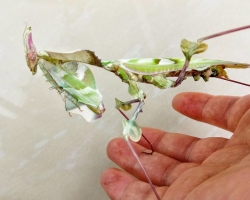In this article, you will learn about how the phytolamp from the LED lamp differs. Many people with pleasure at home grow flowers, other plants. And the room does not have enough lighting, because they use phytolamps. They are best suited for the process. LED ordinary lamps do not have the right characteristics. Next, we will learn in more detail what the differences between LED phytolamps and ordinary ones.
Content
- What is the difference between a phytolamp and a regular LED lamp?
- Are ordinary LED emitters suitable for growing plants?
- What is the difference between phytolamps and LED lamps: what does the phytolamp mean?
- What is the difference between the LED lamp and the phytolamps: how does the LED lamp work?
- Differences in LED lamps and phytolamps: how to choose a phytolamp?
- Video: How is the phytolamp differ from the usual LED lamp - the backlight for seedlings
What is the difference between a phytolamp and an ordinary LED-a question that excites amateur gardeners. The main difference between lamps is the phytolamps designed for plant lighting. They were created for this. Thanks to the required number of blue, ultraviolet, red radiation, the light source provides all the necessary processes for the growth of plant crops.
Previously, mercury-containing lamps were used for these purposes, they had a short service life, and polluted the environment due to the content of mercury. Therefore, LED phytolamps and lamps began to use. The differences between simple and phytolamps from LED tapes in the radiation spectrum. Speaking in a simple way, they have different colors. Next, we consider the issue in detail.
What is the difference between a phytolamp and a regular LED lamp?
For the normal growth of seedlings and colors, it is necessary to use lamps, since daylight is not enough. And ordinary LED lamps do not give such an effect as phytolamps.

What is the difference between a phytolamp and an LED lamp - we will find out further.
- When choosing a phytolamp or a regular LED lamp Consider the appearance of the products. In phytolamps, the housing itself is made of aluminum, it has a ribbed shape. Such materials and forms are used not just like that, they act as a radiator for a lamp. Also, the light from the lamp is evenly scattered in all directions.
- LED lamp With a smooth perforated case, they make them from plastic, which conducts heat. They do not have the same spectrum of light radiation as phytolamps. The latest light sources (phytosvetils) are made with a radiating surface, which illuminates the plants with rays directed at an angle of 65-90 degrees. For the light source to work perfectly, it is equipped with lenses. Thanks to focusing lenses, phytolamps can cover the angles of 180-200 degrees. A convex surface of lenses contributes to the process of proper distribution of rays.
- LED light sources They are used for ordinary lighting, they have a wider spectrum of light rays. In order for plants to receive the right amount of light, mainly blue, red, orange radiation. The remaining colors of rays for growing plant crops are not needed. The only thing that is done in order to phytoslights The eyes did not annoy their bright purple color - it adds green. So the glow gives shades softer.
Advantages fitolamps made of LED tapes and ordinary LED lamps The fact that they do not have toxic fillers, like the ESL. Also, these lamps are not afraid of electricity shutdown. They have a compact design, there is enough power supply for their operation. LEDs and phytolamps are durable, they consume little energy. But the price of phytolamps is much higher than the usual LED.
IMPORTANT: There are professional phytolamps, These devices have options for adjusting separate spraying of light rays. You can also regulate the strength of the radiation flow of red, blue. Thanks to this, good conditions are created for plant growth.
The disadvantages of LED phytolamps and simple lamps are that if they have poor heat sink, they heat up, and therefore burn out. If the lamp is of high quality, then there are no such problems. Fitolamps with LEDs do not affect the eyes, color rays are too bright. But for plants, this glow is just right.
Are ordinary LED emitters suitable for growing plants?
What is the difference between phytolamps and LED lamps - the color of the rays. This was mentioned in detail earlier. But is it possible to use simple LED lamps for plants instead of phytolamps, let's find out in detail. Naturally, this topic excites many gardeners, because phytolamps are more expensive than ordinary LED bulbs.
And they are also used for backlighting. Moreover, they are used not only by amateurs, but also by professionals. This is an economy option for plants. Lamps give the right amount of light for plants, flowers on the windowsills. The lamps do not warm at all, only shine. Thanks to low energy consumption, you can save in the world.
IMPORTANT:This option is only suitable for illuminating small zones, where various crops grow, but greenhouses and winter gardens still need to be illuminated with phytolamps.
What is the difference between phytolamps and LED lamps: what does the phytolamp mean?
The main task of the functionality of the phytolamps is to increase lighting to 16-18 hours a day. And the difference between the phytolamp from the LED lamp is already - we have already found out. Thanks to the work, phytolamps can be harvested in greenhouses year -round. LED lamps are suitable only for plant illumination, there is no benefit to use them in everyday life, they are more expensive and the light of the phytosvetter is poorly affected by vision.

Fitolamps with a blue glow are chosen according to the following characteristics: the length of the wave of light should be 446 nanometers, and red LED phytolamps have a length of 660 nanometers, then plant crops will rise well. Only plants, in addition to light, should receive sunlight, that is, stand in the proximity of windows. And for plants that do not get the rays of the sun, they recommend choosing multi -spectral lamps. Such phytolamps imitate the light of the sun, they contain all colors.
Fitolamps, as a rule, are used for:
- Illumination of different plants that are grown near windows or other openings, where there is access to sunlight.
- Growing various types of seedlings, young shoots, which are in the initial form of growing season.
- Slimation of plants that are in rooms or other rooms.
- Growing plants in winter in different objects where there is not enough light.
- Flooding of plant crops, if there is no solar lighting.
- In order to stimulate flowering, as well as fruiting of plants in rooms, greenhouses, etc.
A universal -type lamps for plants are actually suitable for any cultures, because the light of these phytolamps is identical to the sunny.
What are the varieties of phytosovelists?
Almost all LED plant lamps work identical, therefore there are not many varieties. LEDs work thanks to metal semiconductors + and -which are inside small bulbs.
What are the lamps?
- Fitolamps come with different radiation spectrum. They are conditionally divided into monospotal with purple bulbs and with a full spectrum of glow.
- They are also of different brightness. The glow power is determined by markings: SDM5630 - high brightness, for example, and SDM3528 is low brightness. 5630 is the length and width of the diode, respectively, the larger the sizes, the more powerful the lamp.
What is the difference between the LED lamp and the phytolamps: how does the LED lamp work?
If in a conventional lamp the lighting occurs due to the intensity of metal outputs inside due to the exposure of electric energy. And the difference between the phytolamp from the LED lamp is already known. The phytolamp is ideal for lighting plants in rooms. The main difference in devices in the color of the radiation. LED simple lamps do not give such a spectrum of flowers for plant growth.
LED lamps consist of numerous lamps on the tape. Each such light works on the same principle as the intensity lamps. This principle is not complicated. Inside a small glass of glass there are threads made of refractory metals. These threads heat up after including the lamps to the network. Which allows later to illuminate the room. The lamps with a good and high-quality cooling system will work for quite a long time, literally years.
LED lamps vary significantly from the usual incandescent lamps for us, their light spectra is shifted in the infrared side. LED lamps do not actually heat up, in addition, they are completely safe for the life of plant cultures and humans.
Differences in LED lamps and phytolamps: how to choose a phytolamp?
What is the difference between a phytolamp from the LED lamp simple - the appearance and spectrum of colors, as well as purpose. And although phytolamps are specially created for plants by many amateur gardeners still use simple lamps for growing crops.

Thanks to the efficiency of phytolamps, they fully pay for themselves. Plants receive the required amount of lighting. And LED lamps will release a minimum of heat. Therefore, it is unlikely to harm plants.
IMPORTANT: It is necessary to use this lighting option only for small rooms, and for winter gardens and greenhouses, it is still more rational to select other types of lighting devices.
To choose the right phytolamp, consider:
- Whether the ultraviolet spectrum is present in the glow, in large quantities it is harmful to plant crops, it is better to choose lamps without it or with a minimum amount of ultraviolet radiation.
- The impact is harmful and a large amount of high infrared light. Everything should be in moderation.
- Pay attention to low energy -intensive media. To save electricity is an important factor. But take into account the fact that plants should still receive the right amount of light radiation.
- Choose lamps with simple functions and simple maintenance. So that you can easily replace burnt bulbs in lamps.

To obtain a good harvest, it is necessary to correctly install phytosmners, follow the following recommendations:
- To achieve high productivity and good growth of crops, do the following. Make phytolamps as close to cultures as possible. They will illuminate the space well. Only a little should retreat so that there is no negative thermal heating.
- The rays of light from the lamps direct to the plants.
- Install the phytolamp based on the calculation - per square meter should account for about 74 watts, observe the glow range. The lamp should retreat 25-48 centimeters from plant crops.
- In winter, to get a good harvest, increase the number of hours for lighting to five hours a day.
LED illuminators have many advantages, they can work for years, manufacturers boldly give guarantees for such devices. They are installed even at small heights. Because they do not heat up much. Such lamps do not cause a greater intensity of fumes. This helps to avoid frequent watering of plant crops. Thanks to the wide dispersion corner, it is possible to illuminate quite large plots of the land where plants grow, it is not necessary to install many additional reflectors. LED lamps are environmentally friendly and safe, it is not necessary to observe special rules for their utilizations.
Still see the articles on our portal about lamps here:
- LED lamps for lighting a house, apartment;
- What is the difference between LED lamp and UV lamp for manicure?
- Review of powerful lamps for drying gel polish.







